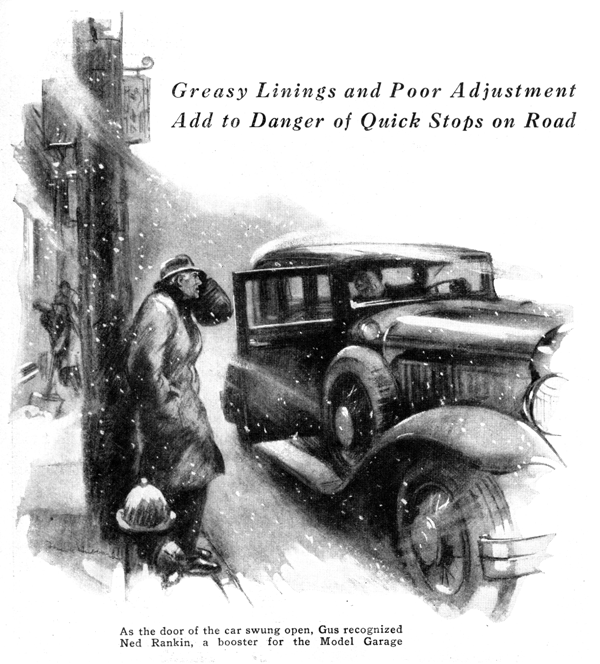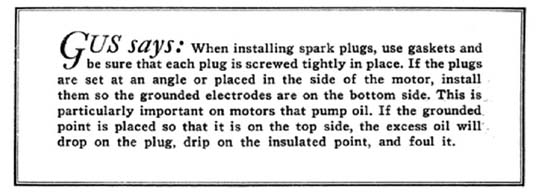February 1933
WHEN BRAKES WON'T HOLD
by Martin Bunn

Fine snow swirled about the frozen ground as Gus Wilson hunched beside a telephone pole, waited impatiently for a cross-town bus.
"Taxi, mister?" called a voice on a snow-covered sedan came to a jerking stop in front of him.
A white curtain of snow hid the driver's face but as the door of the car owner invitingly open, Gus recognized Ned Rankin, one of the best customers and boosters the Model Garage ever had.
"What's the matter, Gus, afraid to drive in the snow?" Gus Rankin grinned.
"No, just giving the car a little over-hauling," replied the veteran mechanic, "and I've had so much other work, I didn't have time to finish it."
"Well, I'm in luck, running into you like this, said Rankin as Gus climbed in beside him. "I was going to stop in and see you some time today. My brakes are on the blink. You heard them squeak when I stopped just now, I've got to stand on the foot pedal to stop the car. I want you to put on some of that dressing that makes brakes hold."
"We don't keep that sort of stuff; it's only a makeshift anyhow." replied Gus. "Why not stop in at the garage and let me look at your brakes. Are the linings very old?"
"No, they've been in only about four months," said Rankin. "They can't be worn out already."
"Weak brakes can come from lots of things beside ordinary wear," Gus informed him. "The linings get glazed over, or dirt gets imbedded in the fabric, or maybe the linings get coated with grease or oil."
"The funny thing is," went on Rankin, "they hold fine when I first start out in the morning. But by the time I've driven a few miles they begin to dip."
"Sounds like grease on the linings," Gus said.
When they reached the Model Garage, Gus drove the car in the rear where his repair bench was located. Joe Clark, Gus's partner and Rankin stood close by as Gus donned his overalls and went to work.
"If brakes hold when they're cold and slip when they heat up, it's generally a sign grease is causing some of the trouble," Gus murmured as he removed one of the wheels and begin scrubbing the grease-coated lining with a stiff brush soaked with gasoline. "Grease from your rear end has been leaking out. I'll have to put new grease retaining washers, when I get through or you'll be having the same trouble all over again.
"Lucky for you, these linings aren't so bad. Sometimes so much grease gets on the brakes that a gasoline bath doesn't help. The only thing to do then is reline."
"Does water have much effect on brake linings?" Rankin asked.
"I'll say it does." Gus replied, "and it acts in two ways. If the linings just get moist, because the car has been left in a damp atmosphere, they'll grab and let out awful squeals. If they get wet through, they won't hold at all.
"Water's an easy thing to get rid of though," Gus pointed out. "All you've got to do is run the car for a short distance with the brakes partly on; the heat of friction will turn the water into steam and leave the linings perfectly dry."
"Remember that old touring car I had some years ago?" Rankin recalled. "Every time I'd put on the brakes, they'd chatter like a couple of pet parrots. What caused that?"
"Generally, chatter is caused by loose parts," said Gus as he put a wheel back into place, "but a broken anchor bracket or loose lining rivets will cause it too. Sometimes the brake linings get sticky and chatter, but a gasoline bath will generally remedy that.
"The hardest chatter to locate comes from poor adjustment. If the end of the brake band or shoe is forced into the drum, the lining binds at that point and generally sets up a howl. To be right, the pressure on the lining should be tangential to the drum," Gus explained.
Rankin grunted as he picked up a scrap of brake lining and crumbled it, "It seems to me automotive engineers ought to be able to perfect some sort of brake lining that won't wear out,," he said. "They make bearings that outlast a car."
"Bearings and brakes are two different things," Gus reminded him, "In a bearing, we try to reduce the friction between the parts by using a lubricant. With a brake it's just the reverse; we want as much friction as we can get and wherever you have friction, you're bound to have some wear. Your brakes were lubricated and the friction was reduced. That's why they didn't hold.
"I can give you a heavy lining that'll wear like iron," Gus said, as he lifted a roll of fabric from the stock shelves, "but you won't like it." Hard linings are noisier than soft ones. We use the heavy lining on trucks."
"Should brake linings be set at any definite clearance from the drums?" Rankin asked.
"External brakes will bind if they're set up too tight," replied Gus. "The heat generated by friction causes the brakes to expand. On internal brakes, it's a little different, because the expanding drum moves away from the linings and increases the clearance. Internal brakes can be set up a little tighter than external brakes."
"I've never had much luck trying to reline my own brakes," Rankin confessed as he watched Gus equalize the brakes with a portable hand tester that clamped to the rim of the wheel. "I suppose I never learned the knack of it."
"It's easy when you know how," chuckled Gus, "but it's a trick not many car owners know."
"The thing not to do is crowd the lining too much where you apply it. After I've re-lined a set of brakes and adjusted them, I drive the car for a few hundred feet in second gear with the brakes partly on. That helps to smooth out the lining and forces it into place. Then I readjust them, if it's necessary."
"When you're adjusting mechanical brakes don't touch the linkage unless you have to. That'll be set right when you buy the car. On most brakes, the cranks and pull rods should be at right angles when the brakes are fully applied; that gives the greatest possible leverage."
"That reminds me," Rankin interrupted," Ken Doyle, next door to me, says you should always have two or three people in a car when you make any brake adjustments. Is there anything to that idea?"
"That's a good thing to do sometimes," Gus agreed. "You see, on some cars, the rear axle may shift a trifle when the car is loaded and that upsets any adjustment made when the car is empty. By working with an average load, you can get an adjustment that will be fairly good for all conditions."
"How quickly should you be able to stop with four wheel brakes?" Rankin asked when Gus had completed the job.'
"Well," Gus replied after a moment's consideration, "you ought to be able to stop your car easily in about twenty-five feet when you're going twenty miles an hour. Trouble is, most people don't pay enough attention to their brakes to have them work that well. If they did, you wouldn't read about so many accidents.
"The average person thinks more about color schemes, horse power and cigar lighters than he does about brakes. Take my advice, Ned, and test your brakes as faithfully as you change the oil in your motor. You should never forget that your brakes are the main safety feature in your car."
END
L. Osbone 2019
